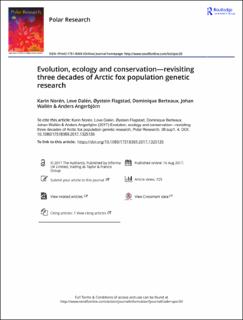Evolution, ecology and conservation - revisiting three decades of Arctic fox population genetic research
Norén, Karin; Dalén, Love; Flagstad, Øystein; Berteaux, Dominique; Wallén, Johan; Angerbjörn, Anders
Peer reviewed, Journal article
Published version

Åpne
Permanent lenke
https://hdl.handle.net/11250/3072094Utgivelsesdato
2017Metadata
Vis full innførselSamlinger
- Publikasjoner fra CRIStin - NINA [2364]
- Scientific publications [1392]
Sammendrag
Three decades have passed since the Arctic fox (Vulpes lagopus) was first put into a population genetic perspective. With the aim of addressing how microevolution operates on different biological levels, we here review genetic processes in the Arctic fox at the level of species, populations and individuals. Historical and present dispersal patterns, especially in the presence of sea ice, are the most powerful factors that create a highly homogeneous genetic structure across the circumpolar distribution, with low detectable divergence between the coastal and lemming ecotypes. With dispersal less pronounced or absent, other processes emerge; populations that are currently isolated, for example, because of the lack of sea ice, are genetically divergent. Moreover, small populations generally display signatures of genetic drift, inbreeding, inbreeding depression and, under specific situations, hybridization with domestic fox breeds. Mating system and social organization in the Arctic fox appear to be determined by the ecological context, with complex mating patterns and social groups being more common under resource-rich conditions. In isolated populations, complex social groups and inbreeding avoidance have been documented. We emphasize the value of genetic data to decipher many previously unknown aspects of Arctic fox biology, while these data also raise numerous questions that remain unanswered. Pronounced intraspecific ecological variation makes the Arctic fox an ideal study organism for population genetic processes and the emergence of functional genomics will generate an even deeper understanding of evolution, ecology and conservation issues for several species.
